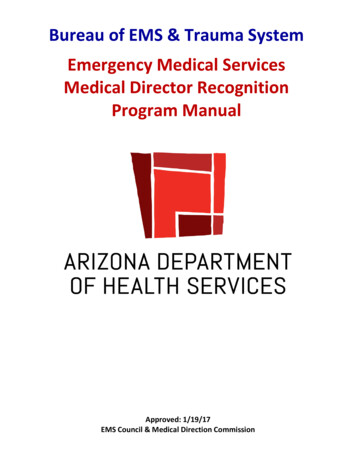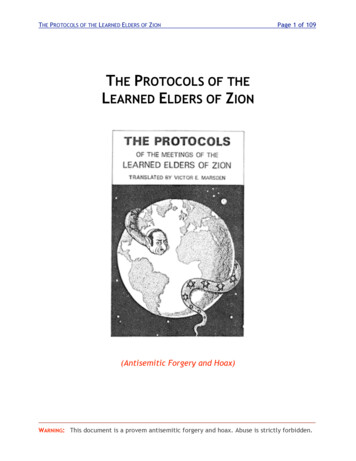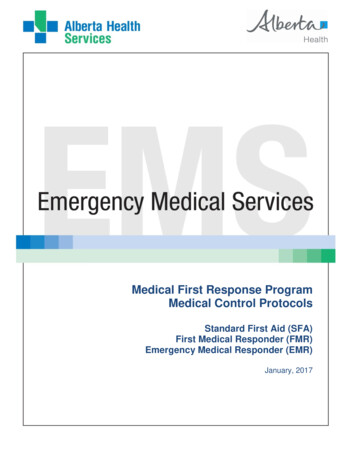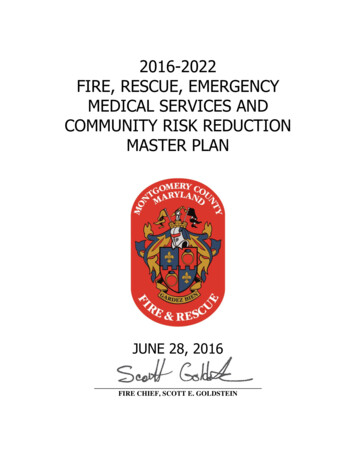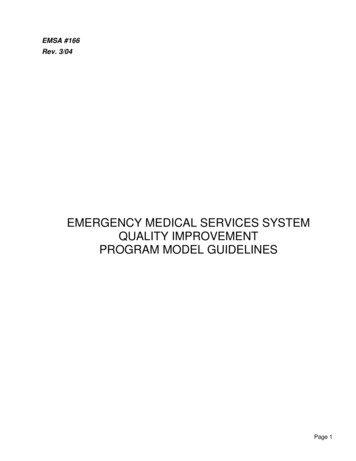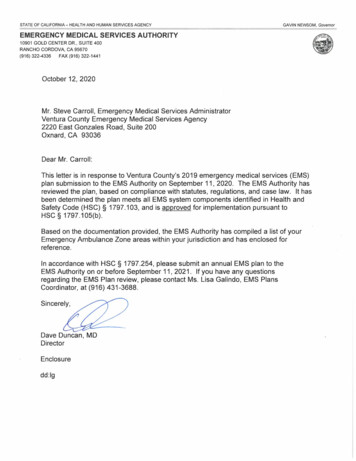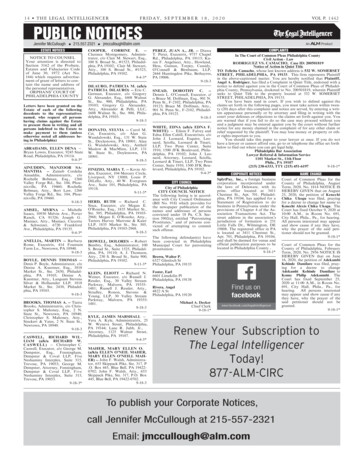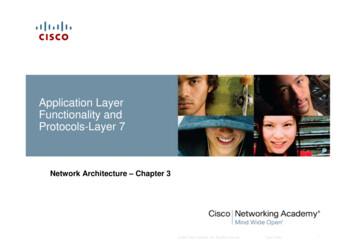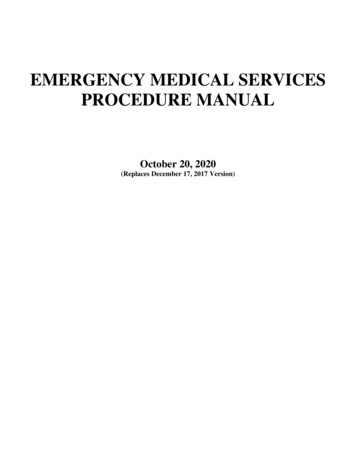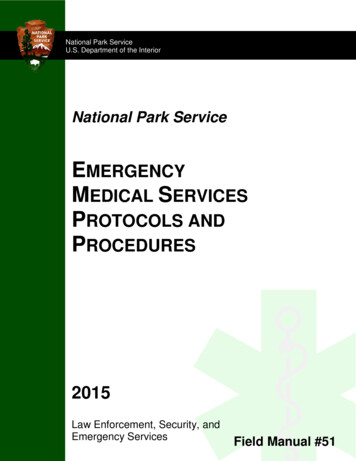
Transcription
National Park ServiceU.S. Department of the InteriorNational Park ServiceEMERGENCYMEDICAL SERVICESPROTOCOLS ANDPROCEDURES2015Law Enforcement, Security, andEmergency ServicesField Manual #51
National Park ServiceU.S. Department of the InteriorEmergency Medical ServicesProtocols and ProceduresThis document is provided forthe National Park Service,Department of the Interior,agencies in connection withactivities.the exclusive use ofemployees of theand other Federalemergency servicesThe information contained in this document may beprivileged, confidential and protected fromdisclosure.Any unauthorized review, use, disclosure,dissemination, distribution, or copying of thiscommunication or any of its contents is strictlyprohibited.Dean RossDeputy Chief, LESESEmergency Servicesdean ross@nps.gov202.513.7093National Park Service1201 Eye Street NWWashington, DC 20005
ContentsGeneral00100020How to Use this ManualTerms, Acronyms & AbbreviationsProcedures1010Automated External Defibrillator (AED)1020Base Hospital Contact Criteria1025Base Hospital Call In Reporting Format1030Blood Glucose Determination1040CPAP1041Electronic Control Device (ECD)1042Endotracheal Intubation1043Epinephrine Ampule1045Epinephrine Auto-Injector1050Fracture/Dislocation Management1060Gamow Bag1070Intraosseous (IO) Access1080IV Access and IV Fluid Administration1085King Tube1095Mucosal Atomizer Device1100Multi-Casualty Reporting & Triage1105NAAK/Mark I (Nerve Agent Antidote)1110Nasogastric/Orogastric Tube Insertion1120Needle Thoracostomy1130Oxygen Administration1133Pain Management1135Pelvic Stabilization1140Rectal Drug Administration1150Spine Immobilization1170Transtracheal Jet Insufflation1180When to Initiate a PCR1190Wound CareProtocols2005Abdominal Pain2010Allergic Reactions2020Altered Mental Status/Altered Level ofConsciousness (ALOC)2030Altitude Illness2035Altitude Illness Prophylaxis2040Bites and Stings2050Burns2060Cardiac Arrest with AED (Adult Medical)2065Cardiac Arrest without AED (Adult Medical)2070Chest Pain (Cardiac)2080Childbirth2090Electrical and Lightning Injuries2100Eye Trauma2110Frostbite2115General Medical Illness (Adult)2120Heal ajor Trauma2160Minor and Isolated Extremity Trauma2180Pediatric – Major Trauma2190Pediatric – Medical Arrest with AEDNPS EMS Field ManualVersion: ediatric – Medical Arrest without AEDPediatric – Medical Illness/FeverPediatric – Newborn ResuscitationPediatric ParametersRespiratory DistressSCUBA/Dive InjurySeizuresShock Without TraumaSubmersion/Near DrowningTrauma Arrest (Adult and Pediatric)Vaginal phen (Tylenol)Acetazolamide (Diamox)Activated CharcoalAlbuterol or Metaproterenol SulfateAmiodaroneAspirin (Acetylsalicylic Acid)Atropine SulfateBacitracin OintmentCefazolin Sodium (Ancef)Dexamethasone (Decadron)Dextrose 50% (D50)Diphenhydramine (Benadryl)EpinephrineErythromycin Ophthalmic OintmentFentanyl (Sublimaze)GlucagonGlucose Paste or Gel (Glutose)Hydromorphone (Dilaudid)Ibuprofen (Motrin, Advil)Ipratropium (Atrovent)KetamineLidocaineMagnesium Sulfate 50%Midazolam (Versed)Morphine SulfateNaloxone (Narcan)Nifedipine (Adalat, Procardia)NitroglycerinOndansetron (Zofran)Oxytocin (Pitocin)Pralidoxime Chloride (2PAM)Sodium BicarbonateGeneral 0000
GENERAL INFORMATIONHow To Use This ManualManual Organization.Sections: the manual is organized into four sections. Subjects are organized alphabetically withinthe sections and numbered as follows (see Table of Contents):General Information Section rugs3000-3999.Subject: each individual subject is identified in the subject page header and footer by:Subject Title:Header.Manual Title:Footer, lower left.Manual Revision Date:Footer, lower left.Manual Section:Footer, lower right.Subject Number:Footer, lower right.Table of Contents: Each Procedure, Protocol, and Drug is listed by section, in alphabetical andnumerical order. Gaps in the number sequence allow future entries to be inserted in thecorrect order.Protocol Organization and Definitions.EMT and Parkmedic Protocols: each protocol is organized into “EMT” and “Parkmedic” sections,each of which contains “Standing Orders” followed by “Base Hospital Orders.” A “SpecialConsiderations” section at the end of the protocol contains background information for theprotocol. “Special Considerations” are for reference only.Standing Orders: items under “Standing Orders” may be done prior to base contact. Unlessotherwise stated, they are written to be completed sequentially.Parks without Base Hospitals: a base hospital is defined as any communications center providingon-line medical direction (i.e. where medical consultation is available in real time bytelephone or radio). Providers in a park without a base hospital essentially operate in constantcommunication failure. Their local medical adviser will establish policies identifying whichbase order interventions, if any, may be performed under these circumstances.Base Hospital/Communication Failure Orders: items labeled “Base Hospital/CommunicationFailure Orders” may be performed by the EMT or Parkmedic only after base hospital contactand approval, OR base contact has been attempted and was unsuccessful. Reasonableattempts to contact base must be made, and communication failure documented.Base Hospital Orders Only: items listed under “Base Hospital Orders Only” require base hospitalapproval and may NOT be performed in communication failure.Navigation: once a protocol is selected, care should be continuous under that protocol. Exceptionsto this rule are:GO TO: if an order directs you to “GO TO PROTOCOL: XXXXX” (protocol named initalics), then patient care should continue under the specified protocol, IF the patientmeets the stated criteria. If the patient does not meet the criteria, then continue withthe original protocol.Cardiac Arrest: if a patient experiences cardiac arrest while being cared for under anotherprotocol, then the Provider may immediately change to the appropriate cardiac arrestprotocol without first making base contact. Base contact, however, should beattempted as soon as possible without compromising patient care.REFERENCE: Additional relevant information is available in another protocol or procedureif an order directs you to “REFERENCE PROTOCOL or PROCEDURE: XXXXX”(protocol or procedure named in italics). This information is intended to supplementknowledge, but patient care should continue to follow the original protocol.NPS EMS Field ManualVersion: 01/15General 0010
GENERAL INFORMATIONProtocols are chief complaint driven and are designed for patient care. Protocols contain ordersfor the appropriate care of the patient.Procedures are step by step instructions in how to carry out a specific action in the care of a patient(e.g. IO needle insertion).Drug Pages are designed to be informational. Therefore, as drug dosing may vary depending onthe selected protocol, the range of dosing used throughout the manual is listed in the drugpage; when caring for a specific patient, the administered dose is that designated in theprotocol. Depending on the drug, the dose may be listed as mg/kg or ml/kg. Generic namesare always used and in cases where the brand name is commonly used, this will also be listed(e.g. Midazolam/Versed).Pediatric Patients: most protocols and procedures apply to both adults and children. Certain protocolsapply only to pediatric patients, and are listed separately under Pediatric. Depending on theprocedure, protocol, or drug dose, the age definition of pediatric varies; if age is not specificallydefined, then assume that pediatric refers to the age range of 0-14 years.Park Specific Scope of Practice Modifications.In general this NPS EMS Field Manual is designed to be used unmodified as it is part of ReferenceManual 51 (RM 51) and under Director’s Orders 51 (DO 51), and thus carries the weight of NPSPolicy. However, given the wide range of needs and unique environments within the NPS, somelocal modifications may be necessary and appropriate for specific parks or park areas. Thesemodifications will be made and approved by the Local EMS Medical Advisor (LEMA) and areauthorized within an individual park or park area under his/her medical license. For exampleparks with no high altitude areas, may have no need for the Altitude Protocols or Drug pages.If any local (park specific) modifications are made to the NPS EMS Field Manual:The Field Manual should contain a copy of the local park’s Scope of Practice Modifications(Procedures, Protocols, and Drugs), inserted in the appropriate section(s).Modified, deleted or added (Procedures, Protocols, and/or Drugs), should be listed andidentified as such in the Table of Contents.Procedures and Protocols removed from Practice at a local park should be included in theGeneral Information section so that EMS Providers have access to the informationshould they be detailed to or transfer to another park.If a local park chooses to modify the Field Manual (Procedures, Protocols, and/or Drugs),these steps should be followed:The modification must be approved in writing by the LEMA.The modified version will include the local park acronym, e.g., SEKI, and revisiondate in the version data in the subject footer (i.e. Version SEKI 3/09).The local version will have the same topic number if it is a modified version ofan existing protocol or procedure (e.g. 2010.SEKI).The modified version should be inserted into the NPS Field Manual, innumerical order, for local use.The modified version should be listed in appropriate order on the Field Manualcontents page.For procedures or protocols that are additions to the Field Manual, these will belocally designated as above, but given a unique number that places them inappropriate alphabetic order in the local version of the Field Manual.Manual Updates/Modification Guidelines.Most organizations update their medical guidelines periodically (e.g. AHA). Although these updateswill be reviewed and incorporated into the Field Manual if relevant, these changes will usually beadopted during the normal Field Manual revision cycle.Submitting suggestions: Comments may be submitted through any local EMS Coordinator to theBranch Chief for EMS Services, WASO. The NPS has National Medical Advisors and maintainsan NPS EMS oversight committee that meets periodically to consider recommended changes andupdates to the NPS EMS Field Manual.NPS Definitions.Refer to RM-51 for provider levels.NPS EMS Field ManualVersion: 01/15General 0010
GENERAL INFORMATIONTerms, Acronyms and OCLRAirway, Breathing, Circulation.Advanced Cardiac Life Support.Automated External Defibrillator.Altered Level of Consciousness.Advanced Life Support.Against Medical Advice.Acute Mountain Sickness ORAltered Mental Status.Aspirin.Basic Life Support.Bag Valve Mask.Chief Complaint.Congestive Heart Failure.Central Nervous System.Carbon Monoxide.Chronic ObstructivePulmonary Disease.Carbon Dioxide.Continuous Positive Air Pressure.CardioPulmonary Resuscitation.Circulation, Sensory, Motor.Dextrose 50%.Diver’s Alert Network.Diastolic Blood Pressure.Do Not Resuscitate.Emergency Medical Service.Emergency Medical Technician.Endotracheal Tube.Foreign Body Obstruction.Glasgow Coma Score.Gun Shot Wound.Gastro-Intestinal.High Altitude Cerebral Edema.High Altitude Pulmonary Edema.Held-Held Nebulizer.Heart sseous.Intrauterine Device.Intravenous.IV Fluids.IV Push.Jugular Venous Distention.Local Emergency Medical Advisor.Last Menstrual Period.Level of Consciousness ORLoss of Consciousness.Lactated Ringers.NPS EMS Field ManualVersion: CRPEPMHPOPOVPRNR/OROMRRSBPSC or VS Mucosal Atomizer Device.Multi-Casualty Incident.Metered-Dose Inhaler.Myocardial Infarction.Mechanism of Injury.National EMS Medical Advisor.Naso-Gastric.National Park Service.Non-Rebreather Mask.Normal Saline.Non-Steroidal Anti-InflammatoryDrug.Nitroglycerin.Nausea and Vomiting.Oxygen.Over The Counter.Patient Care Report.Pulmonary Embolism ORPhysical Exam.Past Medical History.Per Os (By Mouth).Privately-Owned Vehicle.Pro Re Nata (As Needed).Rule Out.Range of Motion.Respiratory Rate.Systolic Blood Pressure.Subcutaneous.Self-Contained UnderwaterBreathing Apparatus.Slow IV Push.Sublingual.Shortness of Breath.Signs and Symptoms.Sexually Transmitted Disease.Treat and Release.Total Body Surface Area.Tricyclic Antidepressant.Transient Ischemic Attack.To Keep (Vein) Open.Traumatic Pelvic Orthotic Device.Transtracheal Jet Insufflation.Upper Airway Obstruction.Vital Signs.Greater Than.Greater Than or Equal To.Less Than.Less Than or Equal To.General 0020
Automated External Defibrillator (AED)Scope of PracticeEMR, EMT, Parkmedic, and ParamedicIndicationsAny patient 28 days old in cardiac arrest (unresponsive, not breathing, and pulseless).If you suspect but cannot confirm arrest for any reason (e.g., possible agonal breathing),attach the pads and turn on the AED.If a non-arrested patient is at risk for arrest, bring the AED to the patient’s side. Do notattach the pads to the patient unless the patient becomes unresponsive.Do not delay treatment or transport (per Step 2), in order to bring the AED to the scene.ContraindicationsPatient is not in cardiac arrest; patient is 28 days old; patient is a victim of obviouslyfatal trauma, meets the criteria for declaration of death, or has a known DNR.EquipmentAutomated External Defibrillator (AED)Procedure1.2.3.4.5.NotesFOLLOW PROTOCOL: Cardiac Arrest/Dysrhythmias; Pediatric- CardiacArrest/DysrhythmiasProvide 2 minutes of CPR prior to using the AED; if the AED can be applied within4 minutes of a known sudden collapse, skip initial CPR and proceed to Step 3.Turn on AED and follow prompts (attach pads, analyzing, shock advised/not advised, etc).After each “Shock Delivered” or “No Shock Advised” message, immediatelyprovide CPR until AED prompts for next analysis (approx. two minutes). Checkpulse only if prompted by PROTOCOL.After pulse check: if pulse present turn AED off but leave it attached to the patient incase of re-arrest; continue PROTOCOL. If pulse absent continue CPR until AEDprompts for next analysis; continue PROTOCOL.Minimize number and duration of interruptions to CPR. No interruption longer than 10seconds. Provide CPR while AED charges, if possible. Deliver other interventions(airway, IV, medications) during CPR.Before applying pads: move patient from water and dry off wet/sweaty skin.Remove transdermal medication patches and wipe off medication (e.g. Nitropaste).Place pads at least one inch from an implanted pacemaker.For adults, use adult pads with adult energy doses only. For children, (for AED use,defined as age 1 – 8; for CPR, defined as age 1 – 14). Child pads with child energydoses are preferred if available, otherwise use adult pads with adult energy doses. Donot use adult energy doses with child pads or child energy doses with adult pads.Do not allow pads to touch each other. If pads are too large to both fit on the front of thepatient without touching, place one pad on right upper chest and the other on the left back(see package for diagram).Do not use AED in moving vehicles. Stop vehicle to prevent interference with AED analysis.Do not focus only on the AED. Monitor patient for signs of resuscitation (e.g. colorchange, pupil response, spontaneous respirations).AEDs may have different programming. If AED prompts conflict with PROTOCOL,follow the PROTOCOL.If declaration of death, leave pads attached to patient.Save data stored by the AED regardless of patient outcome.Cross ReferenceProtocols:Abdominal PainAllergic ReactionsAltered Mental Status/Altered Level of Consciousness (ALOC)Cardiac Arrest/DysrhythmiaChest Pain – CardiacElectrical and Lightning InjuriesHypothermiaNPS EMS Field ManualVersion: 01/15Protocols:Ingestion/PoisoningPediatric Cardiac Arrest/DysrhythmiaRespiratory DistressSeizuresShock Without TraumaSubmersion/Near DrowningProcedure1010
Base Contact CriteriaGeneralBase contact is to be made as specified in individual protocols.Base contact should be attempted if no protocol exists for an individual patient’sparticular complaint.Base contact is always an option but is NOT required in the followingcircumstances: Patients transported with normal vital signs, normal mental status and anon- life- threatening complaint. Patients signed out “Against Medical Advice” with normal vital signs,normal mental status and a non-life-threatening complaint. Patients treated and released (TAR) per criteria in specific PROTOCOL.If base contact is indicated but cannot be made, proceed by individual PROTOCOL anduse your best judgment. Make base contact as soon as possible. Document inability tocontact base.NPS EMS Field ManualVersion: 01/15Procedure1020
Base Hospital Call In Reporting FormatScopeEMT, Parkmedic, and ParamedicIndicationBase contact for non MCI call-insFormatIdentification: unit number (call sign), name, EMS certification.Condition:STAT- UNSTABLE: Unstable vitals or potential threat to life or limb.STAT – STABLE:Stable vitals with potential threat to life orlimb.NON-STAT:Stable vitals, no threat to life or limb.MEDICAL:If most severe problem is medically-based.TRAUMA:If most severe problem is trauma-based.Reason for call: e.g. medication request, AMA, ETA call-in, destination,etc Location; environment; elevationETA: transport type; destinationPatient Profile: age, gender, weightChief Complaint: include mechanism of injury/illnessMental Status: i.e. Adult: alert and oriented. Pediatric: playful, interactive, eye contact,consolableGlasgow Coma ScoreVital Signs: respiratory rate, lung sounds, respiratory effort; pulse, blood pressure,capillary refill; pupils; skin (cool/warm, pale/pink, dry/clammy)Past Medical HistoryAllergiesMedicationsPhysical Exam: pertinent positives and negativesonly Treatment given or interventions completed: includepatient response to treatmentRequests for Additional Therapy or adviceNote: in STAT cases, EMS providers may call in an “incomplete report” if immediatefeedback or guidance from base physician is desired.If traumatic injuries sustained, relay base hospital trauma activation code during call-in.NPS EMS Field ManualVersion: 01/15Procedure 1025
Blood Glucose DeterminationScopeEMT, Parkmedic, and ParamedicIndicationsAltered mental status in any PROTOCOLSeizureSyncopePatients with symptoms of hypoglycemia, especially those with a history of diabetesPatients with diabetes (in any protocol)ContraindicationsNoneEquipmentGlucometer, test strips, cotton ball, lancet, alcohol pad, glucoseComplicationsBleeding, infectionProcedure1.2.3.4.5.6.NotesFollow instruction manual in conjunction with instructions below.Venous blood from an IV catheter, before attaching IV tubing, may be used or go toStep 3.Swab finger with an alcohol pad. Allow finger to dry before attempting fingerstick.Prick the side of the finger with the lancet. Dispose of lancet in sharps container.Test blood sample in accordance with glucometer instruction manual.Reassess the patient. If you are unable to obtain an accurate blood glucose readingfor any reason, and the patient has ALOC or seizure, administer glucose, dextrose,or glucagon according to PROTOCOL as if the patient were hypoglycemic.Device may need calibration or control test before use on patient, per instruction manual.Check expiration date of test strips and control solution (both may have different openedand unopened expiration dates).Cross ReferenceProtocols:Altered Mental Status/Altered Level of Consciousness (ALOC)Altitude IllnessCardiac Arrest /DysrhythmiasHeat IllnessHypothermiaIngestion/PoisoningMajor Trauma – AdultNear DrowningPediatric – Cardiac Arrest/DysrhythmiasPediatric – Major TraumaSeizuresShock Without TraumaNPS EMS Field ManualVersion: 01/15Procedure1030
Continuous Positive Airway Pressure (CPAP)Scope of PracticeParkmedic and ParamedicIndicationsSevere shortness of breath (bronchospasm including COPD and asthma)Severe shortness of breath with pulmonary edema (including congestive heart failure)Severe shortness of breath with pneumoniaSevere shortness of breath with HAPE (Base contact)Shortness of breath or hypoxia after drowningConscious, breathing spontaneously, and able to follow commandsContraindicationsPediatric patients ( 14 years old)Actively vomitingHypotensive (systolic blood pressure 90)Suspected of having a pneumothoraxAn inability to achieve a good facial seal with the CPAP maskActively coughingUnconsciousProcedureThe patient must be continuously monitored for development of respiratory failure orVomiting.CPAP will be delivered at a continuous pressure of 5 up to 10 cm H2O utilizing 100%oxygen.a. Start CPAP at10 cm H2O and decrease if possible.b. Start oxygen at 100% and titrate for oxygen saturation greater than95% if possible.CPAP may introduce transient hypotension via decreased venous return secondary toelevated intrathoracic pressure.a. If systolic blood pressure falls to less than 80 mmHG, remove CPAP.b. If systolic blood pressure falls between 80-100 mmHG, decreaseCPAP to 5 cm H2O if possible.NotesIn hypertensive, CHF patients - do not delay initial sublingual nitroglycerin administrationto apply CPAP. You may remove mask temporarily for repeated nitroglycerin doses.If patients vomits, develops respiratory failure, or is persistently coughing, remove theCPAP circuit, clear the airway as necessary to prevent any aspiration, and providerespiratory assistance with either BVM or other advanced airway adjunct.See specific protocols for recommendations regarding Ondansetron, base contact, andpossible resumption of CPAP.Cross ReferenceProcedures:Oxygen AdministrationNPS EMS Field ManualVersion: 01/15Protocols:Altitude Illness (HAPE)Respiratory DistressDrugs:NitroglycerinProcedure1040
Electronic Control Device (ECD)Dart RemovalScope of PracticeEMT, Parkmedic, and ParamedicIndicationStatus post electrical control device (ECD) application with retained dure AssessmentAltered mental status?YESGo to AMS /ALOC ProtocolYESGo toappropriateProtocolNOAre there any other medicalcomplaints?NOIs patient unable to walk?YESGo to AMS /ALOC ProtocolNOACTUAL SCALE / SIZE:Does the patient have any ofthe following: AICD/Pacer Pregnant Taking anti-coagulants(Warfarin/Coumadin)YESYESTransport toappropriatemedical facilityfor furtherevaluationBarb is a straight #8 fishhook with alength of 4mm and the entire dart lengthis less than 1 cm.NOIs the dart in any of thefollowing locations: Above the clavicle Female breasts Genitalia/groin area Hands/small jointsYESYESTransport toappropriatemedical facilityfor furtherevaluationNOProcedureUse universal precautions.Confirm that wire is cut or disconnected from the ECD device.Use one hand (usually non-dominant) to pull and spread skin around the wound area in ataut manner, while keeping fingers at least one inch away from the puncture site.Use other hand to grasp barb, apply forceful in-line traction and quickly pull out.Clean wound area and apply dressing as needed.Dispose of dart barb as a “contaminated sharp”.Check patient’s tetanus status and advise as needed.Document procedure on Patient or Pre-hospital Care Report (PCR), if “yes” to any ofabove questions.Post-procedure treatment and release vitals: Release if [50 HR 110] and [100 SBP 160]; If HR not within normal range, call base hospital. If SBP is between 160-200, wait 10 minutes andrepeat vitals. If SBP 200 or between 160-200 after 10 minute recheck, call base.NPS EMS Field ManualVersion: 01/15Procedure1041
Electronic Control Device (ECD)Dart RemovalSpecial Considerations/Notes:Re-examine patient thoroughly, looking for any other primary or secondary injuries thatmay have occurred directly from the electrical discharge, from the resulting fall or anyphysical struggle before or after patient immobilization.Primary electrical injuries are very rare and there are no confirmed reports of deathdirectly related to ECD induced malignant arrhythmias.Secondary injuries may include, but are not limited to: (1) fall-related injuries such asfractures, lacerations/abrasions, sprains, and intracranial hemorrhage, (2) musclecontraction related injuries such as rhabdomyolysis, renal failure, and (3) any otherinjuries related to subduing an agitated individual. Anti-coagulated patients(Warfarin/Coumadin/Pradaxa, etc.) or patients on anti-platelet agents (aspirin, Plavix,etc.) are at increased risk for these secondary injuries.Review differential (see Behavioral Emergency Section from ALOC protocol) Re: whythe patient may have needed the use of an ECD to begin with: causes include drug andalcohol intoxication, psychiatric illness, developmental delay, head injury and any causesof ALOC (e.g. hypoglycemia, hypoxia, infection, etc.)Excited Delirium Syndrome:Potentially lethal emergency which may be seen in patients with persistentlyviolent/bizarre/agitated behavior, restraints, and/or drug intoxication. Thepathogenesis is not well understood, but is likely multi-factorial, including positionalasphyxia, hyperthermia, drug toxicity, and/or catecholamine-induced arrhythmias.Treatment should focus on reduction of stress (minimize noise/light/patientstimulation), pharmacologic therapy (midazolam/Versed and rapid monitoredtransport. Refer to Behavioral Emergency Section of AMS/ALOC (Protocol 2020).Pregnant Patients:Should also be transferred to a medical facility for further medical evaluation.Abdominal palpation of the uterus size/height (umbilicus 20 weeks) can provide anestimate of gestational age. Size can be misleading in presence of multiplepregnancy, uterine fibroids, or a full bladder.Patients with AICD/Pacer:Are potentially at higher risk of cardiac dysrhythmias or damage to the AICD/Pacer.These patients should be transported for evaluation and assessment of AICD/Pacerfunction.Cross ReferenceProtocols:Altered Mental Status/AlteredLevel of Consciousness (ALOC)NPS EMS Field ManualVersion: 01/15Drugs:Midazolam (Versed)Procedure1041
Endotracheal IntubationScope of PracticeParkmedic (if approved by local Medical Advisor) and ParamedicIndicationsALL must be present:GCS 6Apneic or agonal respirations 6 per minuteContraindicationsDo not use if ANY are present:Suspected narcotic overdose prior to administration of Naloxone; endotrachealintubation may be attempted in suspected narcotic overdose if unresponsive toNaloxone.The patient has a Do Not Resuscitate (DNR) order Intactgag reflexEquipmentCuffed or Un-cuffed Tracheal Tube (size dependent of patient age and height), syringe toinflate balloon (10ml), stylette, laryngoscope handle, laryngoscope blade (Macintosh orMiller blade size dependent on patient age and height), suction, capnography, tubeholder, stethoscope and pulse ain C-spine precautions if indicated.Have suction equipment available and ready.Pre-oxygenate with BVM and oxygen at 15 L/min for minimum one minute prior toendotracheal intubation.Choose appropriate-sized tube based on patient age and size.Check integrity of balloon by fully inflating it briefly; deflate prior to insertion.Endotracheal Tube placement:Lubricate tube (optional).Remove dentures, broken teeth or OPA, if present.Lift tongue and lower jaw with the laryngoscope blade in Left hand, directingforce 45 from the patient with gentle upward and forward lift.Hold Endotracheal Tube in Right hand so that distal tip curves up.Visualize the epiglottis and vocal cords.Introduce Endotracheal Tube tip from the corner of the mouth, careful not toobscure view of the vocal cords, and advance until cuff is past the cords.Fully inflate balloon on Cuffed Endotracheal Tubes.Ventilate patient with bag-valve and 15L/min oxygen.Verify ETT placement:Look for chest rise and assess ease of ventilation.Listen with stethoscope for absence of epigastric air entry while bagging andfor breath sounds in both axillae while bagging.Check for color (purple to yellow) change of End Tidal CO 2 Device or presence ofcapnography waveform.Look for fogging of ETT.Secure ETT as soon as possible.In most patients, a properly placed ETT will have a depthof 3 times the tube size in centimeters (ie: size 7 tube would show the 21cm mark atthe level of the teeth).Reassess adequate tube placement every time patient is moved, per Step 9.MedicationsWith base consultation, sedation (Midazolam) and analgesic (Fentanyl, Morphine,Hydromorphone) administration may be indicated for hemodynamically stablepatients who become agitated or combative following intubation.NotesDo not delay BLS airway, CPR, or AED in order to place an ETT.Endotracheal intubation should occur within 30 seconds. If unable to properlyplace tube within 30 seconds, stop, insert OPA/NPA, ventilate for one minutewith BVM, and reattempt intubation.NPS EMS Field ManualVersion: 01/15Procedure1042
Endotracheal IntubationDo not make more than 3 attempts total (including those with EndotrachealIntroducer) per patient to place ETT. An attempt is defined as any cessation in ventilation inorder to perform laryngoscopy. If either unsuccessful after 3 attempts, or intubation is not feltpossible, proceed to King Tube placement IF patient is 1 year of age. If patient is 1 year ofage, use Bag Valve Mask (BVM) with BLS airway adjuncts.If unable to ventilate with ETT, quickly troubleshoot (suction, kinks, biting obstruction) removetube, insert OPA/NPA, ventilate with BVM and con
2195 Pediatric - Medical Arrest without AED . 2200 Pediatric - Medical Illness/Fever . 2210 Pediatric - Newborn Resuscitation . 2220 Pediatric Parameters . 2230 Respiratory Distress . 2235 SCUBA/Dive Injury . 2240 Seizures . 2250 Shock Without Trauma . 2255 Submersion/Near Drowning . 2260 Trauma Arrest (Adult and Pediatric) 2270 Vaginal .
